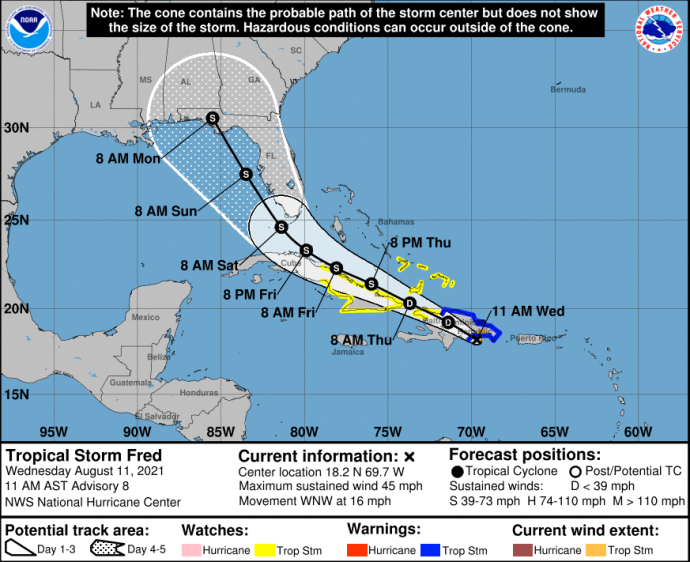Tropical Storm Fred became the sixth named storm of the 2021 Atlantic hurricane season Tuesday night and moved through the Dominican Republic and Haiti Wednesday. The picture above shows the National Hurricane Center’s prediction for the patch of the storm.
As of 11:00 a.m. EST, a tropical storm warning was in effect for the Dominican Republic on the south coast from Punta Palenque eastward and on the north coast from the Dominican Republic/Haiti border eastward.
A Tropical Storm Watch is in effect for the following areas:
- Haiti from the northern border with the Dominican Republic to Gonaives
- Turks and Caicos Islands
- Southeastern Bahamas
- The Cuban provinces of Ciego de Avila, Camaguey, Las Tunas, Holguin, Granma, Santiago de Cuba, and Guantanamo
Fred was centered 25 miles south-southeast of Santo Domingo, Dominican Republic, moving west-northwest at 16 mph. It had maximum sustained winds of 45 mph (75 kph).
The center of Fred is expected to be near or over Hispaniola Wednesday afternoon and evening, move near the Turks and Caicos Islands and the southeastern Bahamas on Thursday, and move near or north of the northern coast of central Cuba on Friday.
The storm could be in Florida as soon as Friday night. Residents in the state were urged to monitor updates.
Fred became a named storm as it was moving through the U.S. Virgin Islands and Puerto Rico.
More than 13,000 customers were without power in Puerto Rico. The company in charge of the transmission and distribution system said those who depend on electricity for life-saving medical devices may need to activate emergency plans.
“Puerto Rico’s system … continues to be very fragile,” the company said, referring to the power grid Hurricane Maria destroyed in 2017.
Puerto Rico Gov. Pedro Pierluisi closed government agencies on Tuesday at noon. According to officials, some gas stations had to shut down after running out of fuel. Eight shelters were opened across the island.
More than a month had passed since the last Atlantic storm, Hurricane Elsa. This time of the year typically marks the start of the peak of hurricane season.
